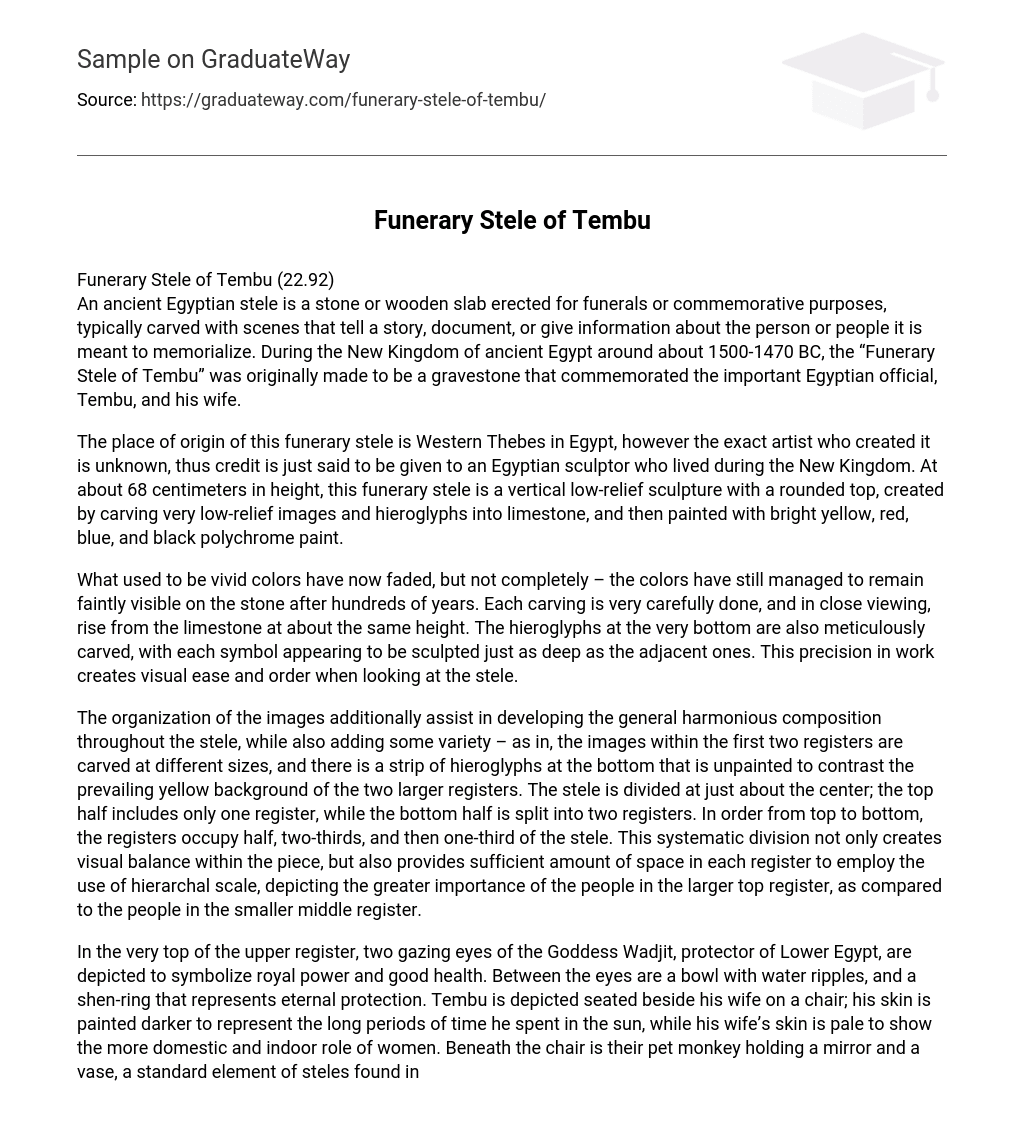An ancient Egyptian stele is a stone or wooden slab designed for funerals or commemorative purposes. These slabs are usually carved with scenes that narrate a story, document events, or provide information about the individuals they are intended to honor. The “Funerary Stele of Tembu” was created during the New Kingdom of ancient Egypt, specifically between 1500-1470 BC. Its original purpose was to serve as a gravestone honoring the significant Egyptian official Tembu and his wife.
The funerary stele originates from Western Thebes in Egypt but its exact artist remains unknown. It is attributed to an Egyptian sculptor from the New Kingdom. Standing at approximately 68 centimeters tall, this funerary stele is a vertical low-relief sculpture with a rounded top. It is made by carving images and hieroglyphs into limestone in a very low-relief style. These carvings are then painted with bright polychrome paint in colors such as yellow, red, blue, and black.
Despite fading over time, the once vibrant colors on the stone are still faintly visible after centuries. The carvings are executed with great care and each one rises from the limestone at a similar height. The hieroglyphs at the bottom are also meticulously carved, with every symbol appearing to be sculpted at the same depth as its neighboring symbols. This precise craftsmanship results in a sense of visual harmony and organization when observing the stele.
The arrangement of the images helps create a unified and balanced composition in the stele. It also introduces some variation; for example, the images in the first two registers are carved at different sizes, and there is an unpainted strip of hieroglyphs at the bottom, contrasting with the yellow background of the larger registers. The stele is divided horizontally, with the top half consisting of one register and the bottom half divided into two registers. The registers occupy half, two-thirds, and then one-third of the stele from top to bottom. This systematic division not only provides visual balance but also allows for the use of hierarchical scale within each register. This scale signifies the greater importance of the people depicted in the larger top register compared to those in the smaller middle register.
At the top of the upper register, the Goddess Wadjit’s two gazing eyes represent royal power and good health in Lower Egypt. The eyes are accompanied by a bowl with water ripples and an ashen ring, symbolizing eternal protection. Tembu and his wife are depicted seated together on a chair. Tembu’s darker skin represents his extensive sun exposure, while his wife’s pale skin signifies her domestic role. Underneath the chair is their pet monkey, holding a mirror and a vase as a personal touch. They sit in front of a table loaded with beef, bread, lotus buds, and vegetables – all of which are thought to be food for the afterlife. Jugs thought to contain wine are positioned below the table. On the far right is their daughter, also portrayed with pale skin, offering a bowl of wine to her father and mother.
The middle register of the stele features other family members, but they are depicted at a smaller size to highlight the focus on Tembu and his wife. Tetu, Tetimose, Teiy, and Ahmose, Tembu’s four sons, are arranged on the right side in ascending order of height, each holding flowers. On the left side, Senetnefer and Henut, his two daughters, are also shown holding flowers to symbolize their presence at a funeral. The two lines of children face each other with a large jar separating them. The jar is adorned with a lotus flower, which represents creation, rebirth, purity, and Upper Egypt. Finally, at the bottom, hieroglyphic inscriptions list the family members depicted on the stele and provide a concise description of each person and their offerings.
The stele portrays the death of Tembu and his wife, with their children attending the funeral to honor and wish them a good afterlife. Each figure and symbol on the stele are depicted in a conceptual and abstract manner. The twisted perspective technique, characteristic of Egyptian art, is applied to every figure, including the monkey. This technique shows their heads and legs in profile, while their shoulders and torso area are depicted frontally. The artwork lacks a sense of depth, particularly in the top register where objects seem to float above the table and the people, adding to the conceptual nature of the piece.
By incorporating spatial balance and symbolism, the “Funerary Stele of Tembu” effectively sheds light on ancient Egyptian culture. It showcases the importance of tradition, the commemoration of significant individuals after their death, and the essentiality of documenting such events. The intricate technical and artistic elements within this piece offer valuable insights into the lives and beliefs of ancient Egyptians during the New Kingdom.





